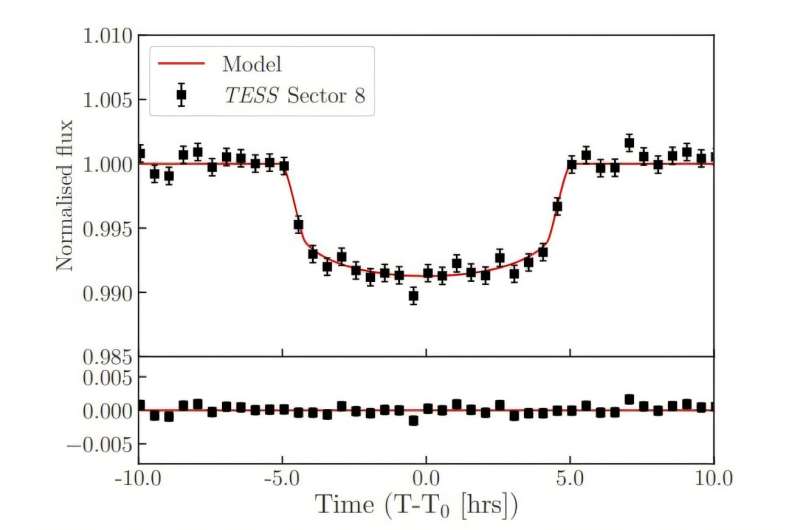Astronomers detect new eclipsing binary system

Using the Transiting Exoplanet Survey Satellite (TESS) and the Next Generation Transit Survey (NGTS), an international team of astronomers has discovered a new eclipsing binary system with a relatively low mass and long orbital period. The finding is reported in a paper published in the Monthly Notices of the Royal Astronomical Society.
M dwarfs, especially in eclipsing binaries (EBs), could be crucial for improving our understanding of fundamental stellar parameters of low-mass stars. In EBs, the orbit plane of the two stars lies so nearly in the line of sight of the observer that the components undergo mutual eclipses. Such systems can provide direct measurement of the mass, radius and effective temperature of stars. In particular, low-mass M dwarfs in long-period eclipsing binaries, in which tidal interaction between the two components is negligible, could help us test stellar evolutionary models.
Now, a group of astronomers led by Toby Rodel of the Queen's University Belfast, UK, reports the detection of a new system of this type. They detected NGTS-EB-7 AB—a low-mass eclipsing binary (LMEB) located some 1,500 light years away.
"NGTS-EB-7 AB was observed by TESS in the Full Frame Images (FFIs) of sectors 6, 7 and 8 at 30-minute cadence; sectors 29, 33, 34, 35 and 39 at 10-minute cadence; and sectors 61, 62 and 66 at 200-second cadence. [...] Following the detection of the initial transit in TESS Sector 8, NGTS-EB-7 was initially monitored by NGTS with 10-s exposures on 15 nights from 2022/04/09 to 2022/06/09," wrote the researchers in the paper.
The observations found that NGTS-EB-7 AB is composed of an evolved G-type primary star and a late M-dwarf companion, separated by approximately 0.66 AU. The system has an orbital period of 193.36 days.
The primary star NGTS-EB-7 A is about 45% larger and 13% more massive than the sun. It has an effective temperature of 5,770 K and its age is estimated to be 10 billion years. The star is most likely metal-rich—with a metallicity at a level of 0.26 dex.
The companion M dwarf NGTS-EB-7 B has a radius of about 0.125 solar radii, while its mass is approximately 0.096 solar masses—therefore close to the hydrogen burning limit and the boundary between main sequence stars and brown dwarfs. The M dwarf orbits the primary star on a highly eccentric orbit, with an eccentricity of 0.71.
Summing up the results, the authors of the paper noted that the parameters of NGTS-EB-7 AB give it one of the longest periods and make it one of the most eccentric LMEBs known to date. They added that the upcoming PLATO mission should detect the secondary eclipse of NGTS-EB-7 B, which will shed more light on the properties of this M dwarf, including its temperature.
More information: Toby Rodel et al., NGTS-EB-7, an eccentric, long-period, low-mass eclipsing binary, Monthly Notices of the Royal Astronomical Society (2024). DOI: 10.1093/mnras/stae2799. On arXiv: DOI: 10.48550/arxiv.2501.04523
Journal information: Monthly Notices of the Royal Astronomical Society , arXiv
© 2025 Science X Network




















